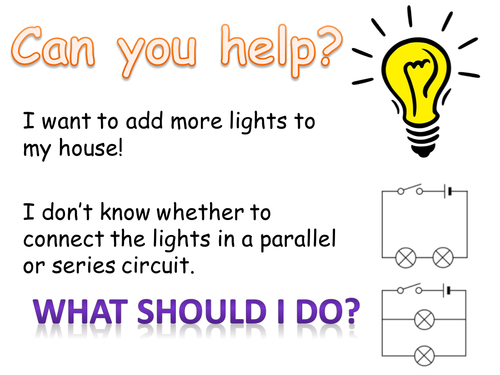



KS3 - Resistance (follows Circuits 2)
Links to prior topics :
Basic physics,
Circuits 1,
Circuits 2,
PD/Current,
series,
parallel
Skills Developed:
Diagrams/graphical work,
physical to abstract,
logic,
problem solving.
Articulation,
relationships between values
Learning Objectives :
Revise PD, electrons and charge
To explain what effects resistance has on the current and PD in a circuit.
Using the concept of resistance to explain how a bulb can blow
Assessment Criteria for Objectives:
Comparison of models
Fill in analogous worksheet
Determine V=IR relationship from experiment
Teaching & Learning Strategies
Experimentation with circuits to practically determine the relationship of V=IxR
Resources / Materials Required
School circuit kit (cells, cables, switches, bulbs)
Ammeters, resistors (1kOhm & 10kOhm)
Lab Safety Considerations [CLEAPSS / Hazcards / COSHH]
Electrical safety (1.5-3v, IE negligible, but still worth pointing out)
Practical Work/Demonstration
Circuit creation – Battery + bulb + ammeter to measure, rope model of a circuit
Literacy /Numeracy/ICT incl. School-wide objectives
Numeracy links with voltage calculations,
literacy with the labels.
Other Broader/Cross-curricular links – [Citizenship, Sustainable Development, Scientific Inquiry, Critical Thinking, Articulation]
Household/hobby electronics,
DT links,
Scientific inquiry
Overview:
Adding lights/ recall series or parallel
Comparison of heating system (water) and electrical circuit
Radiator/water model
Compare resistance / radiators
Keywords
Main Activity
Construct circuit
Get results for current.
Change resistor
Deduce ohms law VIR. Use triangle handout for scaffolding
See if they can infer laws before showing slide.
End question about modelling circuits - extension
Links to prior topics :
Basic physics,
Circuits 1,
Circuits 2,
PD/Current,
series,
parallel
Skills Developed:
Diagrams/graphical work,
physical to abstract,
logic,
problem solving.
Articulation,
relationships between values
Learning Objectives :
Revise PD, electrons and charge
To explain what effects resistance has on the current and PD in a circuit.
Using the concept of resistance to explain how a bulb can blow
Assessment Criteria for Objectives:
Comparison of models
Fill in analogous worksheet
Determine V=IR relationship from experiment
Teaching & Learning Strategies
Experimentation with circuits to practically determine the relationship of V=IxR
Resources / Materials Required
School circuit kit (cells, cables, switches, bulbs)
Ammeters, resistors (1kOhm & 10kOhm)
Lab Safety Considerations [CLEAPSS / Hazcards / COSHH]
Electrical safety (1.5-3v, IE negligible, but still worth pointing out)
Practical Work/Demonstration
Circuit creation – Battery + bulb + ammeter to measure, rope model of a circuit
Literacy /Numeracy/ICT incl. School-wide objectives
Numeracy links with voltage calculations,
literacy with the labels.
Other Broader/Cross-curricular links – [Citizenship, Sustainable Development, Scientific Inquiry, Critical Thinking, Articulation]
Household/hobby electronics,
DT links,
Scientific inquiry
Overview:
Adding lights/ recall series or parallel
Comparison of heating system (water) and electrical circuit
Radiator/water model
Compare resistance / radiators
Keywords
Main Activity
Construct circuit
Get results for current.
Change resistor
Deduce ohms law VIR. Use triangle handout for scaffolding
See if they can infer laws before showing slide.
End question about modelling circuits - extension
Something went wrong, please try again later.
This resource hasn't been reviewed yet
To ensure quality for our reviews, only customers who have purchased this resource can review it
Report this resourceto let us know if it violates our terms and conditions.
Our customer service team will review your report and will be in touch.
£4.00